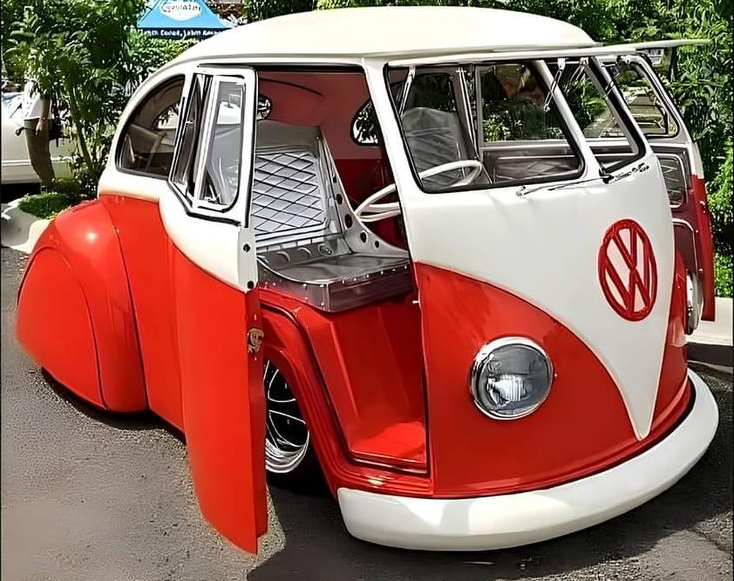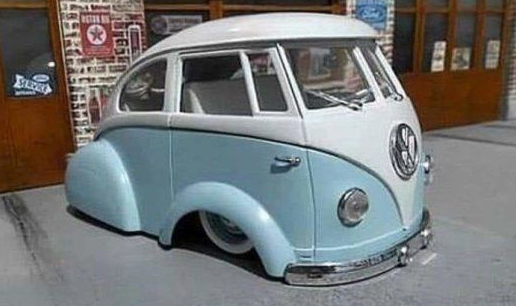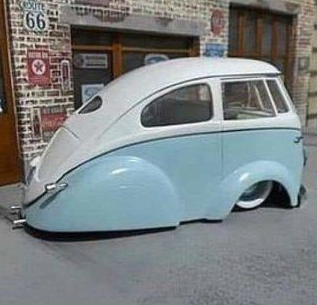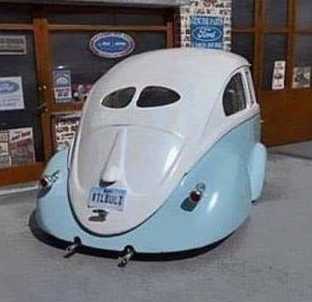O classic car market in Brazil and around the world is hotter than ever. Whether it's nostalgia, a passion for vintage cars or the unparalleled charm of old models, these vehicles are winning over more and more admirers. However, the fusion of classic models is a rare phenomenon that arouses everyone's curiosity. And that's what happened here: a unique car that mixes front of a Kombi with the rear of a Beetle, became a real highlight.
If you are a fan of Volkswagen, you've probably already recognized the distinctive elements of these two icons of the automotive industry. In this article, we'll explore how creativity transformed two of the world's most iconic cars into an automotive masterpiece. We'll talk about the history of the Kombi and the Beetle, the importance of these models for Brazil, and how this incredible design, which we see in the images, manages to combine the best of both worlds.
The History of the Kombi: An Icon of Generations
A Volkswagen Kombi, also known as “Kombion” or simply “Kombi”, is one of the most iconic vehicles in automotive history. There in 1950s, the model was launched in Germany and quickly became a worldwide success. Its production arrived in Brazil in 1957, bringing an unprecedented concept of a versatile, spacious and economical car.
The model was ideal for both cargo transport as for passenger transport, which made the Kombi widely used as commercial vehicle and also in Brazilian families. With its simple construction, robust mechanics and ease of maintenance, the Kombi has lasted for decades and gained the status of classic.
The Kombi's farewell, however, happened in 2013, when Volkswagen ended its production in Brazil. Even so, the Kombi remains alive in the memory of Brazilians, being valued at auctions and by collectors.
Market value: Today, a restored Kombi can cost between R$ 60 thousand It is R$ 200 thousand, depending on the year, condition and history of the vehicle.
The Beetle: The Most Beloved Car in Brazil
If there is a car that has won the hearts of Brazilians, that car is the Volkswagen Beetle. There we are 1930s, the Beetle project began in Germany with the aim of creating an affordable, economical and functional car. It arrived in Brazil in 1950 and it was an absolute success.
The Beetle was known for its durability, simple mechanics and unique rounded design. It was the best-selling car in Brazil for decades, being widely used by families, fleets and car enthusiasts.
To this day, the Beetle has a loyal fan club, which organizes meetings, exhibitions and restoration competitions. It is no coincidence that the Beetle is considered a historical heritage of the automobile industry.
Market value: A restored or modified Beetle can cost between R$ 30 thousand It is R$ 100 thousand, depending on the condition of the vehicle and the type of customization.
The Perfect Date: Kombi Front with Beetle Rear

Now, imagine joining two of the most beloved cars in Brazil: the front of a Kombi and the back of a Beetle. The result is what you see in the images: a car with a hybrid design impressive.
Design and Bodywork
This project brings the front characteristic of the Kombi, with its straight lines, wide windows and the classic Volkswagen emblem. rear of the car was replaced by the iconic rear of the Beetle, with its rounded shapes and classic lights.
The body was painted in a scheme bicolor, mixing tones that refer to the vintage colors typical of the time. This type of paint is very common in old cars, as it enhances the retro style and gives the vehicle a unique elegance.
Creative Aspect
This model is a perfect example of creative customization, which goes beyond the ordinary. Uniting two such distinct bodies requires meticulous adaptation and restoration work, ensuring that the final result is harmonious and functional.
You notice that both the Kombi and the Beetle maintain their visual identities, but together they form a unique and incredible car.
The Value of a Custom Template

Projects like this are highly valued among collectors and enthusiasts. Depending on the level of restoration and customization, a hybrid car like this can cost between R$ 80 thousand It is R$ 250 thousand.
The reason for this high price is the cost involved in the adaptation. Custom work requires specialized labor, high-quality materials and hours of dedication.
Conclusion: A True Work of Automotive Art
O hybrid between the Kombi and the Beetle is a masterpiece that celebrates two of the most iconic cars in Brazil and the world. With a two-tone design charming, which combines tones, the model manages to unite the robustness and personality of the Kombi with the elegance and charm of the beetle.
If you're a fan of classic cars and custom projects, this is a perfect example of how creativity and a passion for cars can create something unique and incredible.












